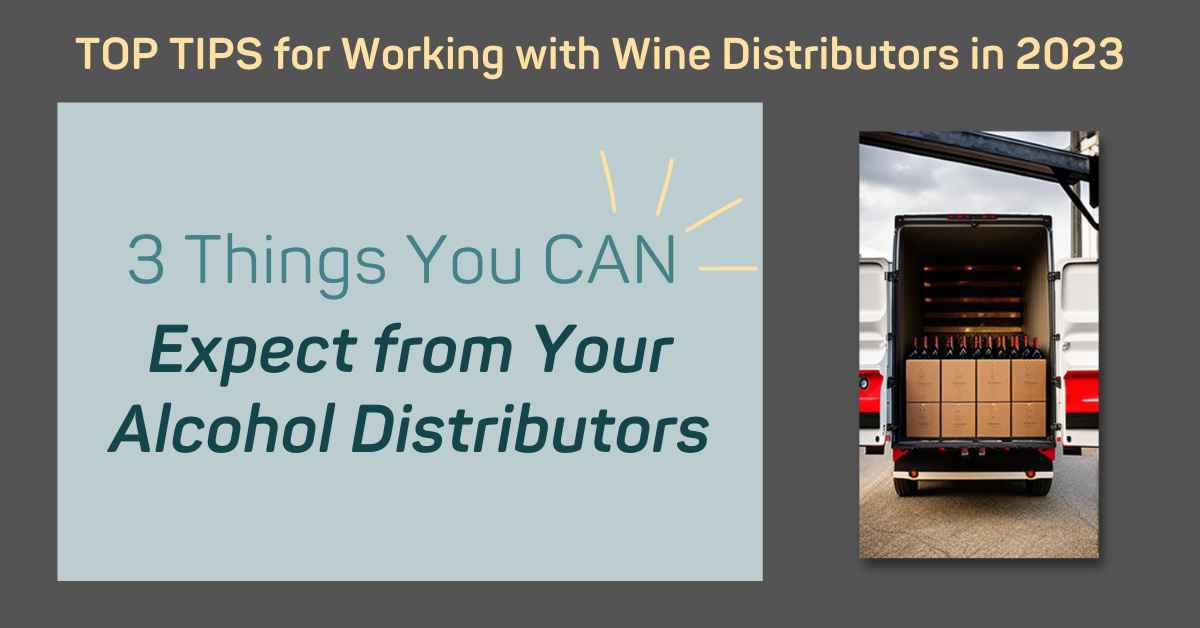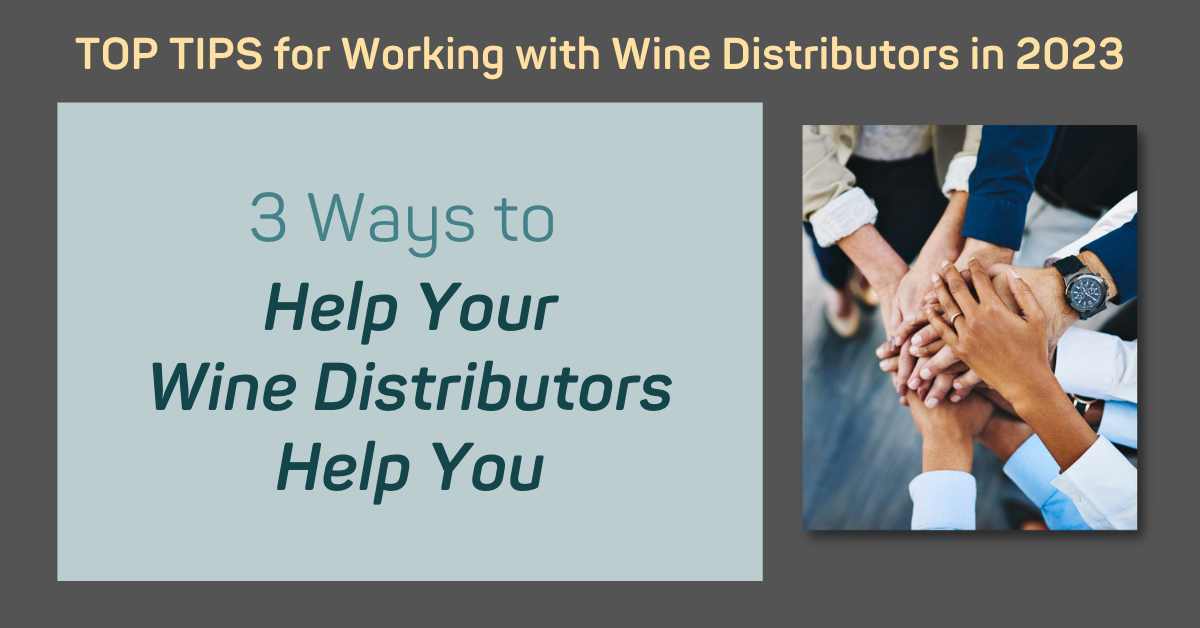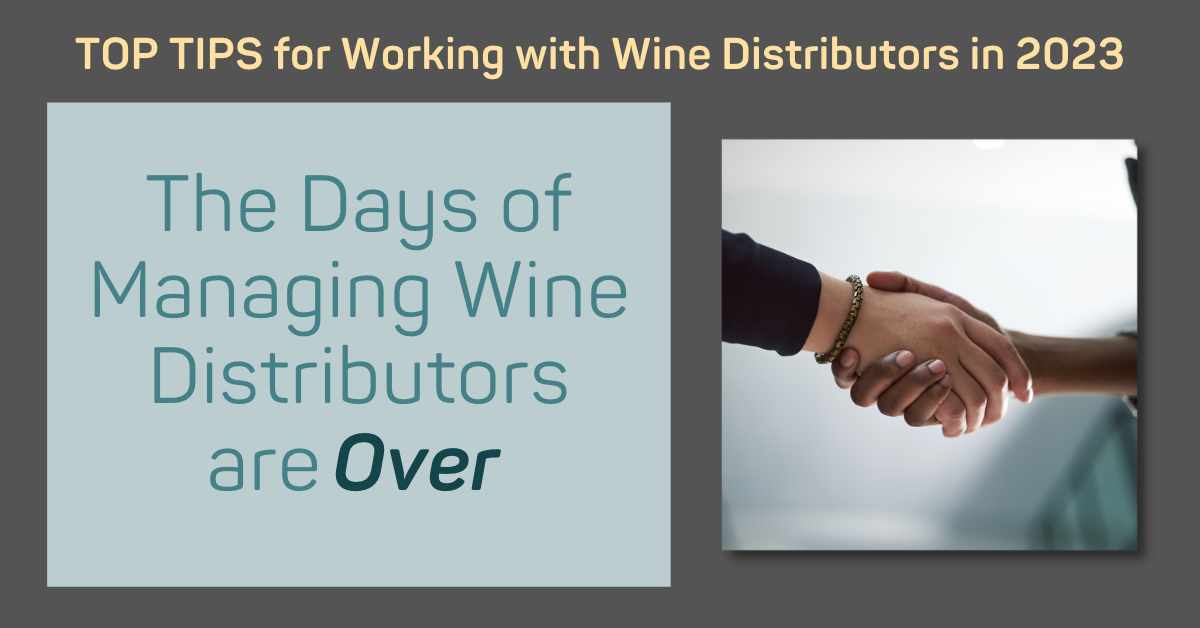3 Things You CAN Expect from Your Alcohol Distributors
When it comes to working with alcohol distributors in 2023, one of the biggest mistakes I see winery and distillery owners make is depending too much...
8 min read
 Ben Salisbury
:
3/22/23 5:33 PM
Ben Salisbury
:
3/22/23 5:33 PM
When it comes to working with wine distributors, it is very common in the wine & spirits industry to pay the distributor(s) to build new points of distribution for you with incentives. Here’s how it typically works: you agree to pay some kind of reward to achieve a specific objective. For wine, it’s often a by-the-glass placement, a wine list placement, a placement on the shelf, or a small display.
For spirits, it’s often a back bar placement or a drink on the cocktail menu. Along with the objective you’re trying to achieve, there’s also typically some kind of qualifier — i.e. – it needs to be three bottles on the back bar before it counts, it needs to be two flavors, it needs to stay on the wine list for a month, etc.
In theory, this sounds like it would be a great idea. “How wonderful to leverage the entire distributor sales team towards building all this new and high-quality distribution.”
Well, stay tuned — I’m going to explain why paying for new distribution incentives just be one of the worst ways to spend your money.
The second reason suppliers pay these distribution incentives is because distributors encourage it. Let’s face it, at any given time, a distributor sales rep has a long list of incentives that they can draw upon. And they use the opportunity to earn money on these incentives to supplement their income. They depend on these incentives to make good money. Because of this, the distributor counts on suppliers bringing an endless array of incentives to offer their wine or spirits sales reps.
It seems like a win-win, doesn’t it? It’s undoubtedly a win for the distributor, and it’s a win for the sales rep. But it is not a win for the brand owner.
There are dozens and dozens of incentives at any given time, so the distributor will constantly ask suppliers to “up their game” and enrich the incentives so that you can compete with all the other rewards that are being offered. It really is a trap, and you’re going to end up way over-paying for distribution that doesn’t stick. (Stay tuned for that.)
The third reason suppliers do it is because it’s EASY. I’m just going to call a spade a spade. There are many good suppliers out there, but there’s also a lot of bad ones.
Sales people are drawing a paycheck from somebody in exchange for managing a specific area of geography and their goal is to increase distribution and sales. In this scenario, unfortunately, not everybody’s going to go out and personally do the hard work that it takes to achieve these objectives.
Instead, they reach out to the distributor and write a new distributor incentive. Just let the distributor do it, right? It is easy enough to do — just write the incentive and stand back and watch the cases roll in.
The problem is it’s also extremely lazy. Didn’t your grandmother teach you that there’s no free lunch? Nothing comes easy in this world. And the things that do come easy, well – let’s just say you don’t want them. And this laziness, this, “Hey, let’s just pay people to go out and put products in distribution.” It is a bad, bad idea.
Paying for new wine or spirits distribution incentives is a VERY bad idea, especially over a long period of time.
There are three main things here that I’m going to talk about. I’m sure there are more, but these are the big ones that you need to take note of.
Here’s the thing. Placements born from these distribution incentives don’t stick. “Churn” is a necessary component of distributors that allows their salespeople to make a lot of money. Unfortunately for suppliers, it means that somebody made a placement, and it was very temporary, and then off the cocktail menu it comes.
If every supplier said, “Hey, we’re going to pay you to put this distribution in place, but it needs to stay in place for six months and generate at least two to three cases a month.” Now, how many incentives are going to make it onto the list that way? There’s not enough room for them all.
.png?width=392&height=523&name=Picture16%20(1).png)
Good luck getting those placements to stick!
I’m going to take an “aside” to note that qualifiers are not all they’re cracked up to be. I know this from my own experience. I think, “Oh, I’m going to be clever. I’m going to put a qualifier in that. I’m only going to pay for this new distribution if it’s in this type of account and it has to stay for one month, and it has to generate these kinds of volumes.” Guess what’s going to happen. No one’s going to qualify. Your incentive is going to be ignored.
You just made it too hard for the sales rep to do it. They’re going to gravitate towards the things that they can churn or the placements that are easy. So then, don’t come to me and say, “Oh, well, I put qualifiers in my incentives. My incentives are just airtight, and there’s no way people are going to get away with this churn.” If that’s you, you are fooling yourself.
As I mentioned above, you’re competing with so many other wine or spirits distribution incentives that the bar is continually rising. I would love to see somebody come up with a chart of what it used to cost to get a back bar placement twenty years ago versus what it costs today.
Today, there are so many products on the market, but there was a time when new distribution incentives did stick because there wasn’t so much pressure to bring in another product right behind it.
Here’s an example. Let’s say you’re launching a new mezcal. You’ve got a great package, and you’ve spent a lot of money on marketing and research. You just know that if you can get it on the back bar and get it into distribution, then you can come back and do Facebook advertising and all of your other marketing to pull it off the back bar, get it on a drink menu, etc.
Okay, well, I got news for you. There are hundreds of mezcals who want the exact same thing. So who’s going to win? Whoever has the richest incentive. It’s a costly way to build new distribution. And the fact that it doesn’t stick makes it even worse.
Distributors aren’t taking care of your brand equity. I don’t mean to offend our distributor friends, but if you look at their warehouse and their book, you’ll see that they can’t afford to be worried about your brand equity. That’s not their business model.
A wine distributor’s business model is to ship products into the market at the right price, not run out of stock, and keep their customers (restaurants and retailers) happy. They do an excellent job with this. They’re constantly raising the bar of how to be more efficient in doing those things. Managing the equity of your brand is not something that’s on their radar. Why should it be? That’s your job.
Unfortunately, if you’re not paying attention, things will happen as a result of these incentives that are destructive to your brand. Here’s an example of how they might hurt your brand equity. Say you put out a nice, rich incentive, and you think, “There’s no way the distributor reps are going to be able to resist this incentive.” That’s true — they won’t resist it. But they’ll do all kinds of things to get that money, including lowering the price, giving away products, or calling in favors. This is not good for brand equity.
Imagine going into a restaurant and saying, “Hey, I saw in my report that you brought in our mezcal; thank you so much… uh, where is it?” In return, the restaurant buyer says, “Oh, well, the distributor rep said if we brought it in and left it on the back bar for a week, he’d give us two tickets to the baseball game.” You have to realize that this stuff is all going on behind the scenes. It has been going on since the repeal of prohibition, and it isn’t good for your brand.
What good was accomplished? So, the bar brought in your brand (as they were asked to do), and the intent was, “Here, just bring this in and just let it lay around for a couple of weeks, and then you can do whatever you want.” How was that good for your brand? It wasn’t a win-win. It was a win for the distributor and the distributor sales rep and at least a minor win for the retailer. (They wouldn’t have done it if it wasn’t.) But this was a HUGE loss for you, the brand owner.
Both the seller and the buyer know that this game is temporary — “churn.” But you must wake up and stop doing it.
If you take away this tool of paying for wine or spirits distribution incentives, what the heck are you supposed to do instead? I have news for you — it’s 2021, and we have way more wine brands and spirits brands than we’ve ever had before in the history of America. We also have vastly fewer distributors than we’ve ever had. You’re going to have to come up with some new things, and you’re going to have to do it yourself. That’s the bottom line.
In the eighties, there was a famous Smith Barney commercial that featured the actor, John Houseman. And he would say, “We make money the old-fashioned way. We earn it.” And that is very much what the climate is like today. You cannot rely on distributors to do what they used to do. They have got too much going on. You’re going to have to do this yourself.
If you are a winery or distillery owner or a sales leader reading this, my next point is for you. I want you to question things very hard. If you have people out in the market that you’re paying a salary and a company car, an expense account and travel and vacations, and health insurance, you better take a hard look at what they’re doing.
If they’re just paying the distributor to do all the work, it’s going to catch up to you. You’re going to have a very fleeting distribution. You’re going to erode the brand equity, and that means you can’t charge as much as you used to. It’s just the natural course of things.
So paying for new distribution incentives, it’s like trying to catch a falling piano. One day you’re going to wake up, and your brand is going to be dead.
So what do you do instead? You’re going to have to take a serious look at the new playbook for selling wine and spirits. If you have read the Wine Sales Stimulator blog before or watched some of my YouTube videos, you already know that I talk a lot about the old playbook versus the new playbook. If you have not seen these videos and articles, let me briefly explain.
The old playbook includes plays such as incentivizing the distributor, educating the distributor, getting in the car and working with the distributor, holding a general sales meeting so you can inspire the distributor and connect with them, etc. I hate to be the one to tell you, but none of this stuff works well anymore.
You’re going to have to generate your own demand and use your own people. You’re going to have to hire people that can get out into the market and personally make placements. That’s the way of the world. The idea that you would pay someone a fat salary to manage a whole bunch of distributors is a dinosaur. It’s going away.
You need young, aggressive, ambitious people who want to work their way up in the world and don’t mind basing a significant part of their compensation on results. Paying people to manage distributors is an antiquated way of doing things. So you need to change who you hire and how you deploy them into the market.
Another thing is you need to be able to generate your own demand. You need to be able to have a relationship directly with trade buyers. You do that with Facebook lead ads and email marketing. These are new plays in the new playbook that most people have no idea how to do. You need to keep track of everything you do in a cloud-based, mobile-friendly CRM and wield your accumulated customer data for a higher Return on Ad Spend and scale your results.
If that sounds overwhelming, you’re not alone. Success in the modern environment for selling Wine & Spirits depends upon your ability to adopt these new strategies. That’s why I founded Wine Sales Stimulator, a group membership program providing winery and distillery owners and executives the training they need to grow sales. If you haven’t already, I encourage you to check out more of our free resources and get some quick wins for your team.
The times have changed and you simply MUST change with them!

When it comes to working with alcohol distributors in 2023, one of the biggest mistakes I see winery and distillery owners make is depending too much...

There is more to working with wine distributors than just telling them what you want done.

Working with wine and spirits distributors has admittedly gotten more complex in recent years.